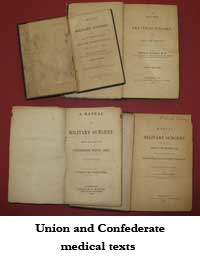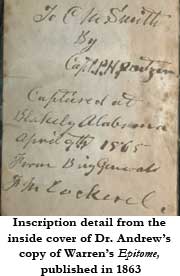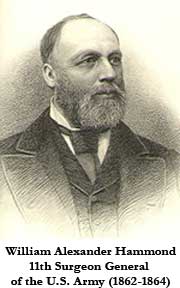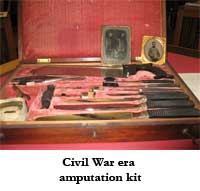By: Ron Sims, Special Collections Librarian
 The current exhibit in the Eckenhoff Reference Room and in the Special Collections reception area highlights some of the American Civil War era texts and artifacts held by the Galter Health Sciences Library Special Collections. Here you can see noted texts and correspondence from both Confederate and Union medical men including Dr. Edmund Andrews, one of the medical school's founders. Nearly all of the founders served in the military, either at Camp Douglas in Chicago or on the battlefields.
The current exhibit in the Eckenhoff Reference Room and in the Special Collections reception area highlights some of the American Civil War era texts and artifacts held by the Galter Health Sciences Library Special Collections. Here you can see noted texts and correspondence from both Confederate and Union medical men including Dr. Edmund Andrews, one of the medical school's founders. Nearly all of the founders served in the military, either at Camp Douglas in Chicago or on the battlefields.
Dr. Andrews acquired the most notable battlefield experience as surgeon in the First Illinois Regiment of Light Artillery, seeing heavy action during Grant’s campaign in Tennessee. Letters from Dr. Andrews were published in the Chicago Medical Examiner during 1862 and described his observations with descriptions of surgeries, conditions of the camps and hospitals, and overall health of the troops.
Confederate medical men
 The exhibit includes a copy of Edward Warren’s An epitome of practical surgery, for field and hospital (1st Edition. Richmond, Va., West & Johnston, 1863) which once belonged to Dr. Andrews. The provenance of the Library’s copy is very interesting. The inside front cover is inscribed "To C. M. Smith by Capt. P. H. [ ? ] captured at Blakely Alabama April 9th 1865 from Brig General F. M. Cockerel," while the signatures "E. Andrews," & "C. E. Paddock" can be found on the flyleaf (click the image at left for additional detail). Dr. Paddock was in the medical school class of 1891 and was Professor of Obstetrics in the 1920s.
The exhibit includes a copy of Edward Warren’s An epitome of practical surgery, for field and hospital (1st Edition. Richmond, Va., West & Johnston, 1863) which once belonged to Dr. Andrews. The provenance of the Library’s copy is very interesting. The inside front cover is inscribed "To C. M. Smith by Capt. P. H. [ ? ] captured at Blakely Alabama April 9th 1865 from Brig General F. M. Cockerel," while the signatures "E. Andrews," & "C. E. Paddock" can be found on the flyleaf (click the image at left for additional detail). Dr. Paddock was in the medical school class of 1891 and was Professor of Obstetrics in the 1920s.
Warren is one of the most bizarre and picturesque figures in the annals of American medicine, having passed through the successive transformations of country doctor, professor, surgeon-general and chevalier of the Legion of Honor. His journeys took him from the swamps of the Carolinas and the shores of the Chesapeake to the Nile and the Seine, practicing on three continents and received everywhere with acclaim.
Born in North Carolina in 1828, he was educated at the University of Virginia. In 1851 he received his MD from Jefferson Medical College and began to practice in Edenton, North Carolina. He then journeyed to Paris in 1854-55. In 1861 he was editor of the Baltimore Journal of Medicine; from 1860 to 1861, he was professor of materia medica at the University of Maryland; in 1867 he reorganized Washington University Medical School, Baltimore and was professor of surgery 1867-71; in 1872 he was one of the founders of the College of Physicians and Surgeons in Baltimore and served as professor there in 1872-73. Governor Vance of North Carolina appointed him surgeon-general of the state and medical inspector of the Confederate States from 1861 to 1865. In 1875 he settled in Paris and died there in September 1893.
His rare and important text, Epitome, was used by nearly every Confederate medical officer. In writing it, Warren consulted a number of leading texts and made no claim to originality. A second edition was planned, but never published.
There are two other Confederate imprints in the exhibit. The first is J. Julian Chisolm’s A manual of military surgery for the use of surgeons in the Confederate States Army; with an appendix of the rules and regulations of the Medical Department of the Confederate States Army (Charleston, Evans & Cogswell, 1861).
Chisolm (1830-1903) was the foremost surgeon in the Confederacy. His important military surgery manual went through three editions and is regarded as one of the most famous artifacts in the history of Civil War medicine. At the outbreak of the Civil War he received the first Confederate military commission issued to a medical officer and attended the wounded at Fort Sumter. His Manual was presented to the Confederate Surgeon-General, Samuel Preston Moore, while the Battle of Bull Run was being fought.
Samuel Preston Moore is the author of the the other Confederate imprint in the exhibit. He graduated from the Medical College of the State of South Carolina in 1834 and quickly became assistant surgeon for the U.S. Army in 1835. This position required service in several frontier regions of the country including Missouri, Kansas, Florida, and the Texas-Mexico border. While serving in the Mexican War (1846-48), Moore met the future President of the Confederacy, Jefferson Davis, who was quite impressed with his organizational and disciplinary abilities.
Moore was promoted to surgeon in 1849 and remained in this position through the 1850s. However, like many Southern officers in the United States Army, he was in crisis while the country was on the brink of civil war. When his home state of South Carolina seceded, he resigned his post in the U.S. Army and moved to Arkansas to open a private practice and to avoid fighting against a country to which he had devoted so much of his life. However, he soon received personal requests from Jefferson Davis to join the Confederate army. Davis’s descriptions of the army’s unfortunate military situation and the lack of trained medical men eventually persuaded Moore to become Surgeon-General in 1861, a position he would hold for the duration of the war.
Moore’s A manual of military surgery (Richmond, Ayers & Wade, 1863) is a compilation of papers by surgeons which provides exact instructions with illustrations for performing operations. It was intended for use by inexperienced surgeons in the army.
Union medical men
 Union authors are well represented in the exhibit and include William Alexander Hammond, MD (1828-1900) who was the 11th Surgeon General of the U.S. Army (1862-1864). In addition to his pioneering work in neurology and his military service, especially during the Civil War, he founded the Army Medical Museum (now called the National Museum of Health and Medicine). He also co-founded the American Neurological Association and gave his name to Hammond's disease, a type of athetosis which he was the first to describe in 1871. In 1863, Hammond published A treatise on hygiene: with special reference to the military service, in which he presents his ideas regarding military medicine.
Union authors are well represented in the exhibit and include William Alexander Hammond, MD (1828-1900) who was the 11th Surgeon General of the U.S. Army (1862-1864). In addition to his pioneering work in neurology and his military service, especially during the Civil War, he founded the Army Medical Museum (now called the National Museum of Health and Medicine). He also co-founded the American Neurological Association and gave his name to Hammond's disease, a type of athetosis which he was the first to describe in 1871. In 1863, Hammond published A treatise on hygiene: with special reference to the military service, in which he presents his ideas regarding military medicine.
Hints on the preservation of health in armies, for the use of volunteer officers and soldiers (New York, Appleton, 1861) was authored by John Ordronaux (1830-1908), who served as an army surgeon stationed in New York. He also acted as a military medical advisor. Between 1861 and 1863 he published two textbooks on the health of armies as well as an instruction manual of medical criteria for examining recruits. A graduate of Dartmouth College and Harvard Law School he earned his MD at the National Medical School in 1859. After the war he taught medical jurisprudence at several eastern institutions.
Charles Stuart Tripler (1806-1866) and George Curtis Blackman (1819-1891) co-authored Hand-book for the military surgeon; being a compendium of the duties of the medical officer in the field, the sanitary management of the camp, the preparation of food, etc.; with forms for the requisitions for supplies, returns, etc.; the diagnosis and treatment of camp dysentery; and all the important points in war surgery; including gunshot wounds, amputation, wounds of the chest, abdomen, arteries and head, and the use of chloroform (Cincinnati, Robert Clarke & Co., 1862).
Tripler and Blackman were both graduates of the College of Physicians and Surgeons in New York. Tripler entered the Army as assistant surgeon and was made full surgeon in 1847. In 1861 he was appointed medical director of General Patterson's army in the Shenandoah Valley. Upon General McClellan's assuming chief command, he was made general director of the Army of the Potomac and organized the medical services in that department. In 1854, Blackman became professor of surgery in the Medical College of Ohio in Cincinnati. During the war he was noted for his bold and skillful technique as surgical operator; he was also an able writer and lecturer.
Periodicals and Correspondence
Also on display is an issue of the American Medical Times, a periodical filled with scholarly medical reports, advertisements for medical books, and offerings of equipment, medicines and false limbs, dated November 15th, 1862. For the purposes of the exhibit it is opened to a page of sample questions typically put to a candidate for the position of Assistant-Surgeon in the U.S. Army: “Examination Questions for Army Surgeon Candidates.” Besides the more typical questions, such as, "Describe the origin, course and distribution of the pneumogastric nerve," are more practical ones like, "what are the best means of getting rid of excrementitious matters of a camp, of a camp hospital, and of a permanent hospital?"
Of special interest is a selection of correspondence and reports from John Theodore Heard (1836-1906). These exquisite hand written materials are excellent examples of military protocol and communication during the Civil War. Heard was educated at the Boston Latin School and at the Harvard Medical School, where he graduated in the class of 1859. After completing his service as intern in the Massachusetts General Hospital, he continued the study of medicine in Dublin and Paris.
When the Civil War broke out, Heard went to the front as assistant surgeon of the Thirteenth Massachusetts Volunteers. He was made major surgeon of United States Volunteers in May, 1862, and assigned as brigade surgeon of the First Brigade, Second Division of the First Army Corps. In October of 1862 he became surgeon-in-chief of the Second Division of the same corps. He was successively medical director of the First Army Corps, surgeon-in-chief of the Artillery Reserve in the Army of the Potomac, and afterward medical director of the Fourth Army Corps of the Army of the Cumberland, with the rank of lieutenant colonel. He took part in the battles of Cedar Mountain, Va., Rappahannock Station, Thoroughfare Gap, the second Bull Run, South Mountain, Maryland, Antietam, Fredericksburg, Va.; Chancellorsville, Gettysburg, in the campaign to Atlanta, Ga.; and also Columbia, Spring Hill, Franklin and Nashville, Tenn.
 Intermixed with the texts are period instruments and equipment including a wooden boxed amputation kit, a folding pocket instrument case, wooden lower leg splint, metacarpal saw, tooth key and tooth extractor, brass bleeders, field stethoscopes and a screw tourniquet .
Intermixed with the texts are period instruments and equipment including a wooden boxed amputation kit, a folding pocket instrument case, wooden lower leg splint, metacarpal saw, tooth key and tooth extractor, brass bleeders, field stethoscopes and a screw tourniquet .
[The exhibit, now closed, was available for viewing through February 2010. The display cases were located in the Eckenhoff Reference Room on the first level and in the reception area of Special Collections on the second level.]
Updated: March 5, 2020